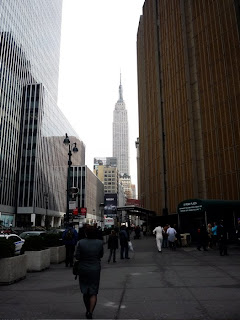New York's New Adolescence and the Play Impulse in Contemporary Public Art
The idea of perpetual childhood seems especially pronounced in food trends, like the unceasing craze for cupcakes, those pretty confections for that special boy and girl (especially those SATC girls), as well as the appetite for fried chicken, gelato on a stick, ice cream of all sorts, chocolate cake, and gourmet hamburgers and hot dogs. Outside of food, many New Yorkers resemble children at play. We ride bikes, carry big backpacks, wear sneakers, and frolic with dogs. Because the Mayor insists we behave, we know we are not supposed to do bad things like smoke or eat too many sugary snacks. And if the development trend continues to replace older neighborhoods with a virtual facsimile of them, then we'll adopt behaviors more typical of an amusement park.
The city playground continues to expand. The conversion of once-working waterfront piers to recreational parks, the addition of hundreds of miles of bike lanes, the construction of new sports stadiums, and the repurposing of a railroad track into a park (the greatest kid fantasy of all) underscore the profound shift from a manufacturing to a consumer and recreational economy. In the realignment of the workforce to an information society, many New Yorkers find themselves in alternative work arrangements, often at home or with the laptop at the coffeehouse or working in a an open floor plan of an office, surrounded by toys, in a kind of Montessori school of the work world. Wherever we are, we seem to need to update others on our status or check in at our current location.
The way that members of the creative class interact with the city has also shifted from the manner previous generations interacted with the city. Growing up on virtual games, enveloped in personal entertainment systems (even while walking), the youthful city dweller conceives of the city as a virtual board game where places become check-in points. With the economy in crisis, many people in the city, even the most highly educated, find themselves underemployed or unemployed, improvising things to do in a summer recess without end. With opportunities for grownup work disappearing, some people start blogs or websites out of necessity or to do something constructive with all that learning they picked up in school. I predict the new LEGO store in Rockefeller Center will be very popular among all age groups.
It's funny but unsurprising that the artwork of such a culture should somehow reflect the spirit of exploration associated with adolescent development. Consider the pubic art projects in the city this summer - Antony Gormley's Event Horizon, Doug and Mike Starn's Big Bambú, Paul Ramírez Jonas's
Key to the City, and Luke Jerram's Play Me - I'm Yours. While these projects encourage participatory democracy and question the ownership of urban spaces, they nevertheless engage the play impulse. With Event Horizon's identical nude male figures, we play a game of find-and-seek, and with Key to the City, we're off on an adventure. Gormley, in his statement about the project for Mad. Sq. Art, even articulates the idea - "I don’t know what is going to happen, what it will look and feel like, but I want to play with the city and people’s perceptions." (See fuller discussion on this website.)
Artist Jonas devised Key to the City, a participatory Creative Time project, to encourage people to explore issues of access and democracy. Upon the presentation of the key at a kiosk in Times Square (now closed, but the key will still work through Labor Day), the adventurer then begins a quest to locate the twenty-four designated sites and unlock their doors. Play Me I'm Yours, with its sixty pianos scattered across the boroughs, depends on our individual and community desires and our ability to play. In regards to Big Bambú, the evolving bamboo edifice on top of the Met, whose inner child cannot relate to the best jungle gym ever?
Engaging such a high level of play while encouraging an exploration of the city takes a lot of work. Believe me, I know all about it. There's nothing inherently wrong, however, with childlike wonder and play and with artworks that depend on the involvement of an active viewer. In his 1794 work, On the Aesthetic Education of Man in a Series of Letters, philosopher Friedrich Schiller equates the "play drive," the resolution of the conflict between sensuality and reason, with artistic beauty. These four art projects also signal the continuing challenge to the notion that artists make art and that the viewers consume or react to it. Works that once said, "Behold me and discern my meaning," now come with the invitation, "Can you come out and play with me?' For these artists, they're tapping into a growing public for whom the inclination to play is never far removed.
Images by Walking Off the Big Apple.








Comments
Post a Comment